Mechanical and Corrosion Behavior of a Composite Gradient-Structured Cu-Fe Alloy
Abstract
1. Introduction
2. Materials and Methods
2.1. Material Preparation
2.2. Mechanical Tests
2.3. Electrochemical Measurements
2.4. Microstructure Examination
3. Results
4. Discussion
4.1. Mechanism for Improving the Strength of Cu-10Fe Alloy via USRP
4.2. Mechanism for Inhibiting the Corrosion Behavior of Cu-Fe Alloy via USRP
5. Conclusions
- (1)
- A composite gradient-structured Cu-10Fe plate was prepared via USRP. The composite structure exhibits a gradual increase in grain size of the Cu matrix and second phase from the topmost surface to the matrix. The depth of the gradient structure is approximately 600 μm.
- (2)
- USRP effectively improved the mechanical properties of the Cu-Fe alloy. The yield strength of the Cu-10Fe alloy increased from 297 MPa to 378 MPa after USRP. The micro-hardness of the surface layer is approximately 0.38 GPa higher than that of the matrix. The improvement in yield strength can be attributed to the refinement of grain/Fe phase size and the enhanced dislocation density. Additionally, the heterogeneous deformation in the gradient structure contributes to the extra strengthening effect.
- (3)
- USRP could enhance the corrosion resistance of Cu-10Fe alloys. The USRPed Cu-Fe sample shows higher corrosion potential, lower corrosion current density and higher polarization resistance, compared to that of the initial Cu-10Fe alloy. The presence of finer grains and Fe phases promotes the formation of a passivation film on the surface during corrosion. Furthermore, the smoother surface achieved through USRP is also beneficial to impede electron release, leading to an enhanced corrosion resistance.
Author Contributions
Funding
Data Availability Statement
Conflicts of Interest
References
- Moon, J.; Park, J.M.; Bae, J.W.; Do, H.S.; Lee, B.J.; Kim, H.S. A new strategy for designing immiscible medium-entropy alloys with excellent tensile properties. Acta Mater. 2020, 193, 71–82. [Google Scholar] [CrossRef]
- Tian, Y.Z.; Peng, S.Y.; Yang, Y.; Pang, X.Y.; Li, S.; Jiang, M.; Li, H.X.; Wang, J.W.; Qin, G.W. Attaining exceptional electrical conductivity in Cu-Fe composite by powder rolling strategy. Scr. Mater. 2023, 227, 115302. [Google Scholar] [CrossRef]
- Liu, S.; Xu, S.; Jie, J.; Zhang, J.; Dong, Y.; Li, X.; Li, T. Microstructure evolution and magnetic properties of metastable immiscible Cu-Fe alloy with micro-alloying B element. J. Alloys Compd. 2021, 888, 161627. [Google Scholar] [CrossRef]
- Tian, Y.Z.; Yang, Y.; Peng, S.Y.; Pang, X.Y.; Li, S.; Jiang, M.; Li, H.X.; Wang, J.W.; Qin, G.W. Managing mechanical and electrical properties of nanostructured Cu-Fe composite by aging treatment. Mater. Charact. 2023, 196, 112600. [Google Scholar] [CrossRef]
- Sikdar, K.; Roy, B.; Mahata, A.; Roy, D. Enhanced thermal stability of nanocrystalline Cu-Al alloy by nanotwin and nanoprecipitate. J. Alloys Compd. 2022, 922, 166273. [Google Scholar] [CrossRef]
- Zhang, Y.; Xiao, Z.; Zhao, Y.; Li, Z.; Xing, Y.; Zhou, K. Effect of thermo-mechanical treatments on corrosion behavior of Cu-15Ni-8Sn alloy in 3.5 wt.% NaCl solution. Mater. Chem. Phys. 2017, 199, 54–66. [Google Scholar] [CrossRef]
- Mordyuk, B.N.; Khripta, N.I.; Zhao, L.G. Twinning-related enhancement in strength and ductility of Cu-37Zn alloy by the cryogenic ultrasonic impact treatment supplemented with ECAP. Mater. Lett. 2022, 310, 131512. [Google Scholar] [CrossRef]
- Rybalchenko, O.V.; Bochvar, N.R.; Rybalchenko, G.V.; Martynenko, N.S.; Tabachkova, N.Y.; Dobatkin, S.V. Comparative analysis of the aging kinetics in low-alloyed Cu—Cr—Hf and Cu—Cr—Zr alloys after high pressure torsion. J. Alloys Compd. 2023, 955, 170246. [Google Scholar] [CrossRef]
- Gong, Q.; Liu, J.; Wu, F.; Chen, H.; Xie, W.; Wang, H.; Yang, B. Precipitation behavior and strengthening effects of the Cu-0.42Cr-0.16Co alloy during aging treatment. J. Alloys Compd. 2023, 936, 168269. [Google Scholar] [CrossRef]
- Duan, X.R.; Chen, Y.; Hong, Z.Y.; Wang, S.W.; Chen, S.F.; Zhang, S.H. Strengthening and toughening mechanisms of P-rich phase in Cu-4Sn-P alloy wire. J. Alloys Compd. 2023, 937, 168410. [Google Scholar] [CrossRef]
- Yang, F.; Zhang, X.; Fang, F. Microstructure and properties of cold-drawn Cu and Cu-Fe alloy wires. IOP Conf. Ser. Mater. Sci. Eng. 2022, 1249, 012057. [Google Scholar] [CrossRef]
- Yang, Y.; Wang, D.; Lin, J.; Khan, D.F.; Lin, G.; Ma, J. Evolution of structure and fabrication of Cu/Fe multilayered composites by a repeated diffusion-rolling procedure. Mater. Des. 2015, 85, 635–639. [Google Scholar] [CrossRef]
- Wang, M.; Yang, Q.R.; Jiang, Y.B.; Li, Z.; Xiao, Z.; Gong, S.; Wang, Y.R.; Guo, C.L.; Wei, H.G. Effects of Fe content on microstructure and properties of Cu–Fe alloy. Trans. Nonferrous Met. Soc. 2021, 31, 3039–3049. [Google Scholar] [CrossRef]
- Ren, L.; Zhang, S.; Shi, J.; Shen, Z.; Shi, P.; Zheng, T.; Ding, B.; Guo, Y.; Xiao, Q.; Li, Q.; et al. Grain refinement and mechanical properties enhancement of Cu-10 wt.%Fe alloys via Zr addition. Mater. Sci. Eng. A 2022, 846, 143309. [Google Scholar] [CrossRef]
- El-Egamy, S.S. Corrosion and corrosion inhibition of Cu–20%Fe alloy in sodium chloride solution. Corros. Sci. 2008, 50, 928–937. [Google Scholar] [CrossRef]
- Moon, J.; Choi, Y.; Sasaki, T.; Joo, M.; Shin, H.; Lee, J.S.; Ohkubo, T.; Hono, K.; Baek, S.M.; Kim, H.S. Corrosion-resistant Cu-Fe-based immiscible medium-entropy alloy with tri-layer passivation. Corros. Sci. 2021, 193, 109888. [Google Scholar] [CrossRef]
- Yan, C.; Xin, Y.; Chen, X.B.; Xu, D.; Chu, P.K.; Liu, C.; Guan, B.; Huang, X.; Liu, Q. Evading strength-corrosion tradeoff in Mg alloys via dense ultrafine twins. Nat. Commun. 2021, 12, 4616. [Google Scholar] [CrossRef]
- Yan, C.J.; Guan, B.; Xin, Y.C.; Zhao, L.Y.; Huang, G.J.; Hong, R.; Chen, X.B.; Chu, P.K. Mechanical and corrosion behavior of a biomedical Mg–6Zn–0.5Zr alloy containing a large number of twins. Acta Metall. Sin. 2022, 36, 439–455. [Google Scholar] [CrossRef]
- Mahmoud, S.S. Electrochemical studies of pitting corrosion of Cu–Fe alloy in sodium chloride solutions. J. Alloys Compd. 2008, 457, 587–592. [Google Scholar] [CrossRef]
- Xu, Q.; Yang, X.; Liu, J.; Jiang, D.; Qiu, Z. Improved corrosion resistance of 42CrMo4 steel by reconstructing surface integrity using ultrasonic surface rolling process. Mater. Today Commun. 2023, 35, 105932. [Google Scholar] [CrossRef]
- Xia, T.; Zeng, L.; Zhang, X.; Liu, J.; Zhang, W.; Liang, T.; Yang, B. Enhanced corrosion resistance of a Cu-10Ni alloy in a 3.5 wt.% NaCl solution by means of ultrasonic surface rolling treatment. Surf. Coat. Technol. 2019, 363, 390–399. [Google Scholar] [CrossRef]
- Zhao, P.C.; Guan, B.; Tong, Y.G.; Wang, R.Z.; Li, X.; Zhang, X.C.; Tu, S.T. A quasi-in-situ EBSD study of the thermal stability and grain growth mechanisms of CoCrNi medium entropy alloy with gradient-nanograined structure. J. Mater. Sci. Technol. 2022, 109, 54–63. [Google Scholar] [CrossRef]
- Wu, X.; Jiang, P.; Chen, L.; Yuan, F.; Zhu, Y.T. Extraordinary strain hardening by gradient structure. Proc. Natl. Acad. Sci. USA 2014, 111, 7197–7201. [Google Scholar] [CrossRef] [PubMed]
- Wang, Y.F.; Huang, C.X.; Wang, M.S.; Li, Y.S.; Zhu, Y.T. Quantifying the synergetic strengthening in gradient material. Scr. Mater. 2018, 150, 22–25. [Google Scholar] [CrossRef]
- Koga, N.; Tomono, S.; Umezawa, O. Low-temperature tensile properties of Cu-Fe laminated sheets with various number of layers. Mater. Sci. Eng. A 2021, 811, 141066. [Google Scholar] [CrossRef]
- Guo, F.A.; Xiang, C.J.; Yang, C.X.; Cao, X.M.; Mu, S.G.; Tang, Y.Q. Study of rare earth elements on the physical and mechanical properties of a Cu–Fe–P–Cr alloy. Mater. Sci. Eng. B 2008, 147, 1–6. [Google Scholar] [CrossRef]
- Lin, H.R.; Tian, Y.Z.; Sun, S.J.; Zhang, Z.F. Microstructural evolution and mechanical properties of laminated CuAl composites processed by accumulative roll-bonding and annealing. Acta Metall. Sin. 2021, 34, 925–931. [Google Scholar] [CrossRef]
- Wang, M.; Jiang, Y.; Li, Z.; Xiao, Z.; Gong, S.; Qiu, W.; Lei, Q. Microstructure evolution and deformation behaviour of Cu-10 wt.% Fe alloy during cold rolling. Mater. Sci. Eng. A 2021, 801, 140379. [Google Scholar] [CrossRef]
- Zhang, D.; Pan, H.; Zeng, Z.; Xie, D.; Li, C.; Li, J.; Tang, W.; Yang, C.; Qin, G. Variable mechanical properties due to gradient microstructure in a dilute Mg-Mn-Ca-Ce alloy subjected to bidirectional forging. Mater. Today Commun. 2023, 35, 105543. [Google Scholar] [CrossRef]
- Liu, R.; Chen, D.; Ou, M.; Liang, Y. The effect of initial grain size on the strength property of copper with gradient microstructure. J. Mater. Res. Technol. 2023, 24, 407–417. [Google Scholar] [CrossRef]
- Cheng, Z.; Bu, L.; Zhang, Y.; Wu, H.; Zhu, T.; Lu, L. Characterization of gradient plastic deformation in gradient nanotwinned Cu. Acta Mater. 2023, 246, 118673. [Google Scholar] [CrossRef]
- Li, X.; Nakatani, M.; Yang, J.; Zhang, J.; Sharma, B.; Pan, H.; Ameyama, K.; Fang, J.; Zhu, X. Investigation of mechanical properties and microstructural evolution in Cu─Al alloys with gradient structure. J. Alloys Compd. 2022, 890, 161835. [Google Scholar] [CrossRef]
- Lu, K. Making strong nanomaterials ductile with gradients. Science 2014, 345, 1455–1456. [Google Scholar] [CrossRef] [PubMed]
- Chen, D.; Mao, X.; Ou, M.; Liang, Y. Mechanical properties of gradient structured copper obtained by ultrasonic surface rolling. Surf. Coat. Technol. 2022, 431, 128031. [Google Scholar] [CrossRef]
- Wan, T.; Cheng, Z.; Bu, L.; Lu, L. Work hardening discrepancy designing to strengthening gradient nanotwinned Cu. Scr. Mater. 2021, 201, 113975. [Google Scholar] [CrossRef]
- Stratmanm, M.; Streckel, H. On the atmospheric corrosion of metals which are covered with thin electrolyte layers--i. Verification of the experimental technique. Corro. Sci. 1990, 30, 681–696. [Google Scholar] [CrossRef]
- Li, Y.R.; Lin, W.M.; Wei, H.Y.; Hou, L.F.; Du, H.Y. Electrochemical corrosion behavior of mechanical attrition treated surface layer with nanocrystallines on Cu-10Ni alloy. Corros. Sci. Prot. Technol. 2012, 24, 397–400. [Google Scholar]
- Balusamy, T.; Sankara Narayanan, T.S.N.; Ravichandran, K.; Park, I.S.; Lee, M.H. Influence of surface mechanical attrition treatment (SMAT) on the corrosion behaviour of AISI 304 stainless steel. Corros. Sci. 2013, 74, 332–344. [Google Scholar] [CrossRef]
- Chen, X.; Han, Z. A low-to-high friction transition in gradient nano-grained Cu and Cu-Ag alloys. Friction 2020, 9, 1558–1567. [Google Scholar] [CrossRef]
- Lee, H.H.; Park, H.K.; Jung, J.; Amanov, A.; Kim, H.S. Multi-layered gradient structure manufactured by single-roll angular-rolling and ultrasonic nanocrystalline surface modification. Scr. Mater. 2020, 186, 52–56. [Google Scholar] [CrossRef]
- Olugbade, T.O.; Lu, J. Literature review on the mechanical properties of materials after surface mechanical attrition treatment (SMAT). Nano Mater. Sci. 2020, 2, 3–31. [Google Scholar] [CrossRef]
- Zhou, M.; Xu, Y.; Liu, Y.; Duan, M.; Xia, Z.; Huang, L.; Zhu, R.; Ye, H.; Peng, L.; Wu, Y.; et al. Microstructures and mechanical properties of Mg-15Gd-1Zn-0.4Zr alloys treated by ultrasonic surface rolling process. Mater. Sci. Eng. A 2021, 828, 141881. [Google Scholar] [CrossRef]
- Ye, H.; Sun, X.; Liu, Y.; Rao, X.X.; Gu, Q. Effect of ultrasonic surface rolling process on mechanical properties and corrosion resistance of AZ31B Mg alloy. Surf. Coat. Technol. 2019, 372, 288–298. [Google Scholar] [CrossRef]
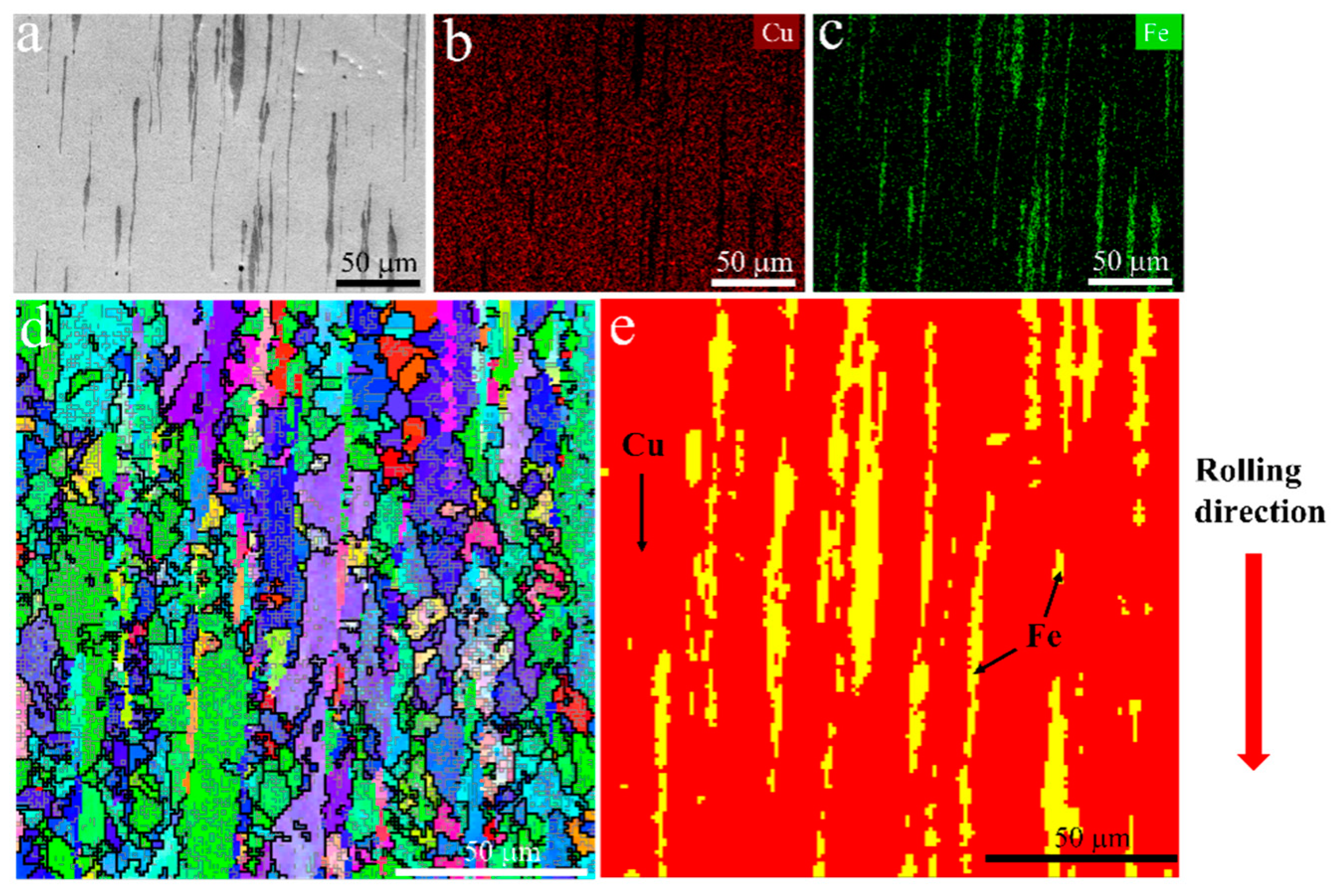


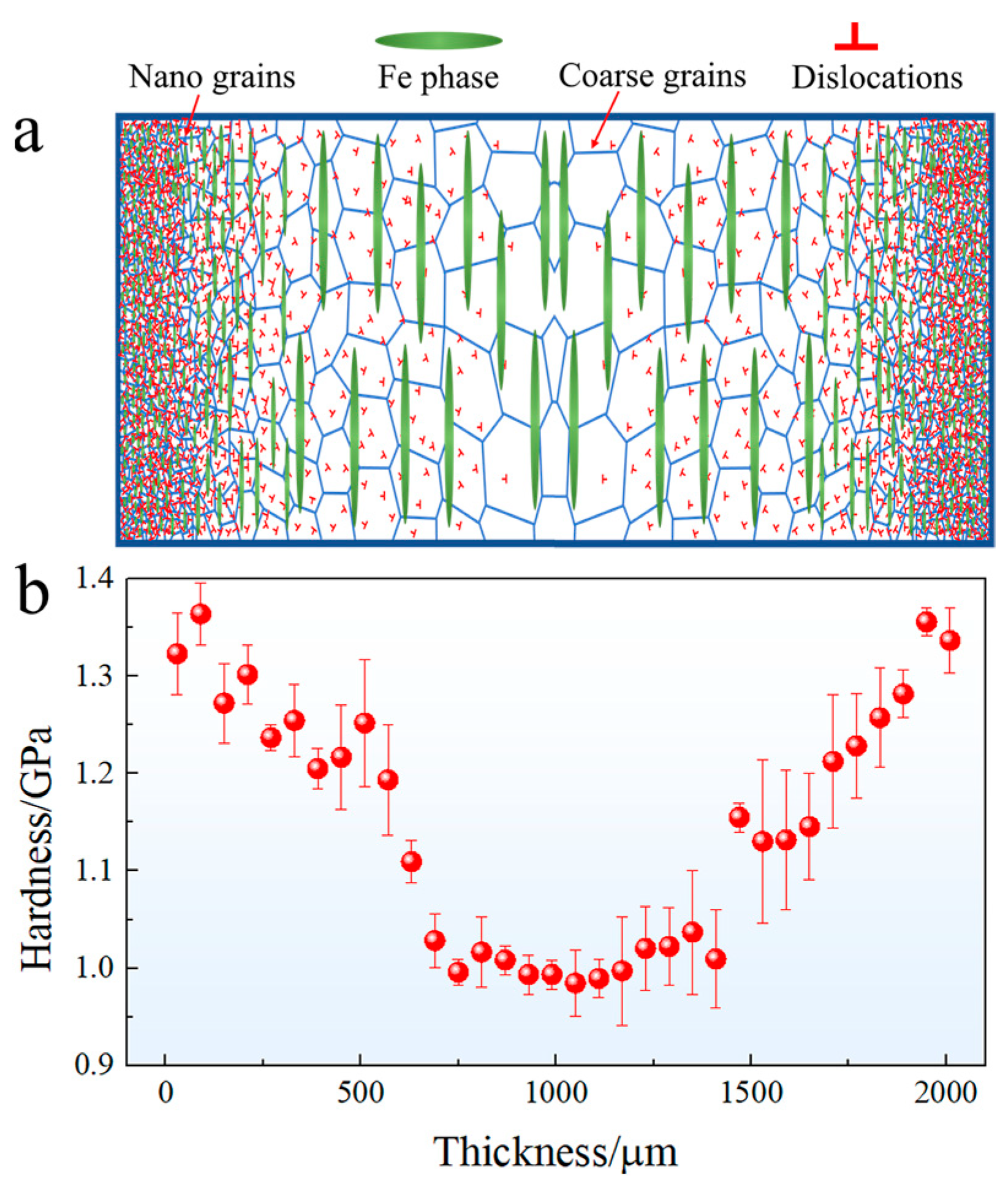
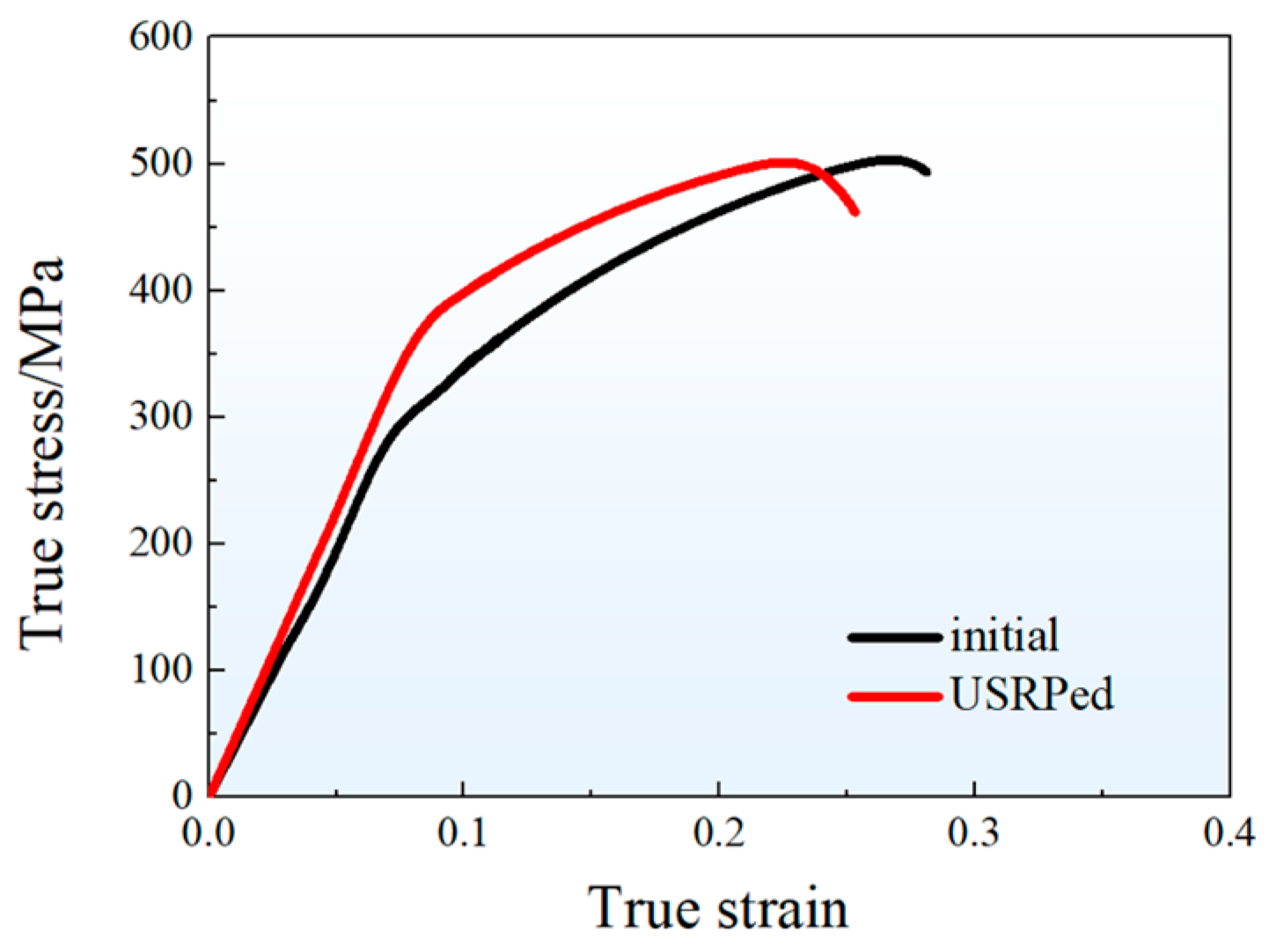
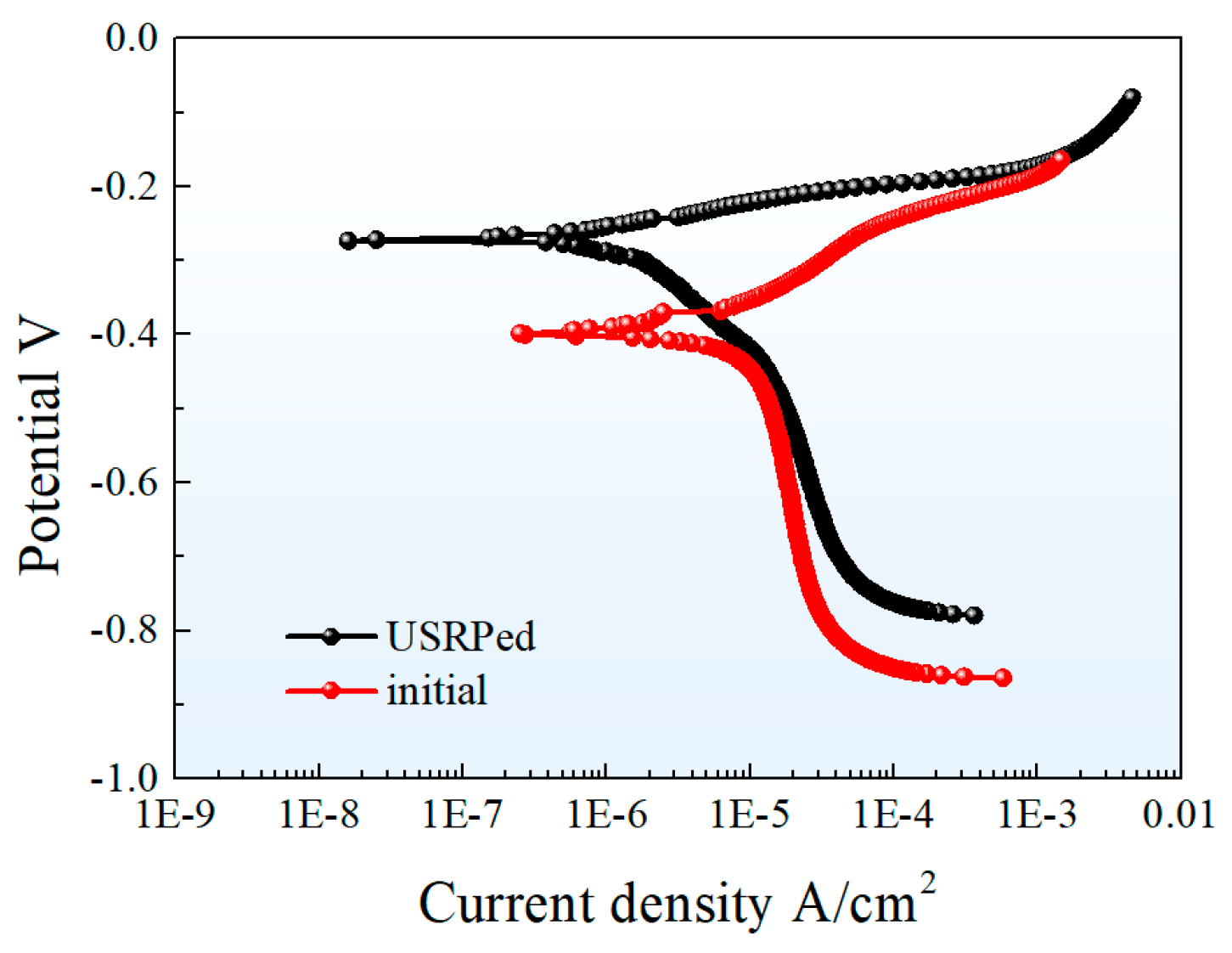
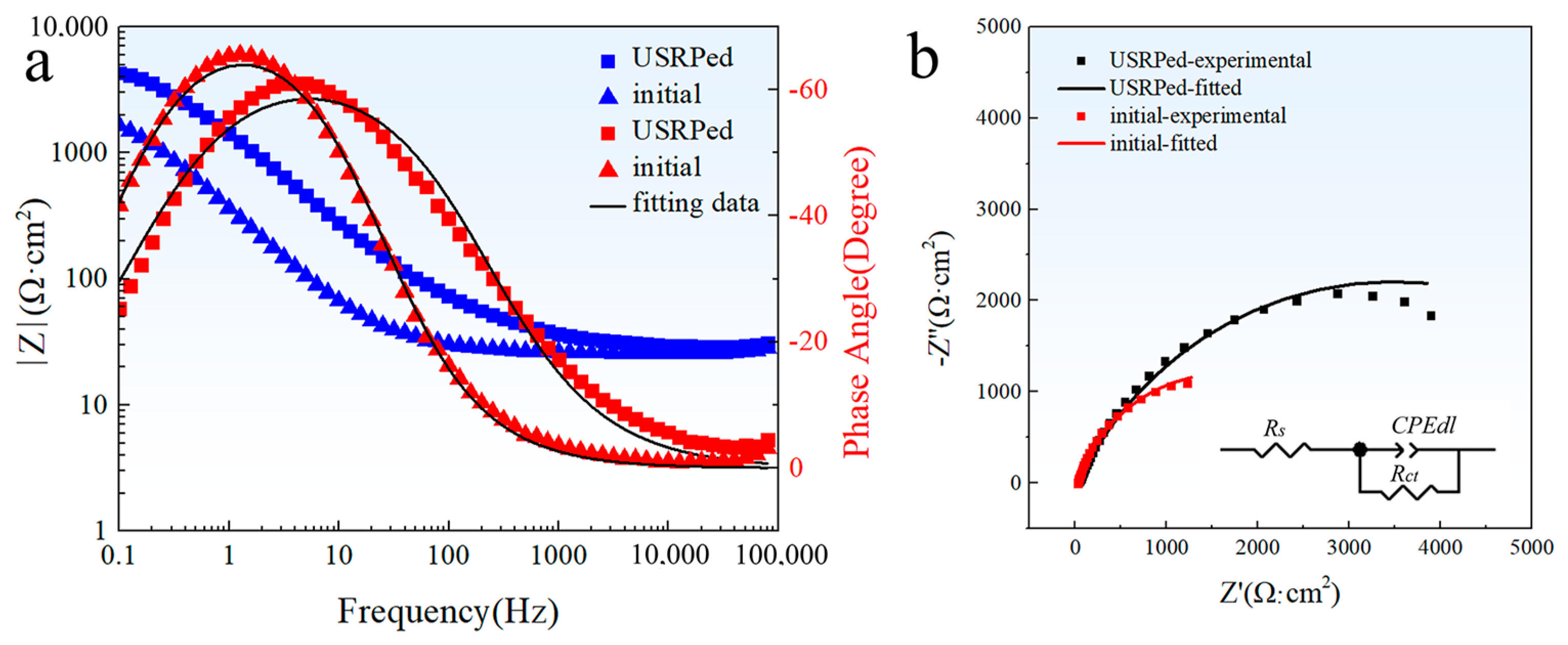
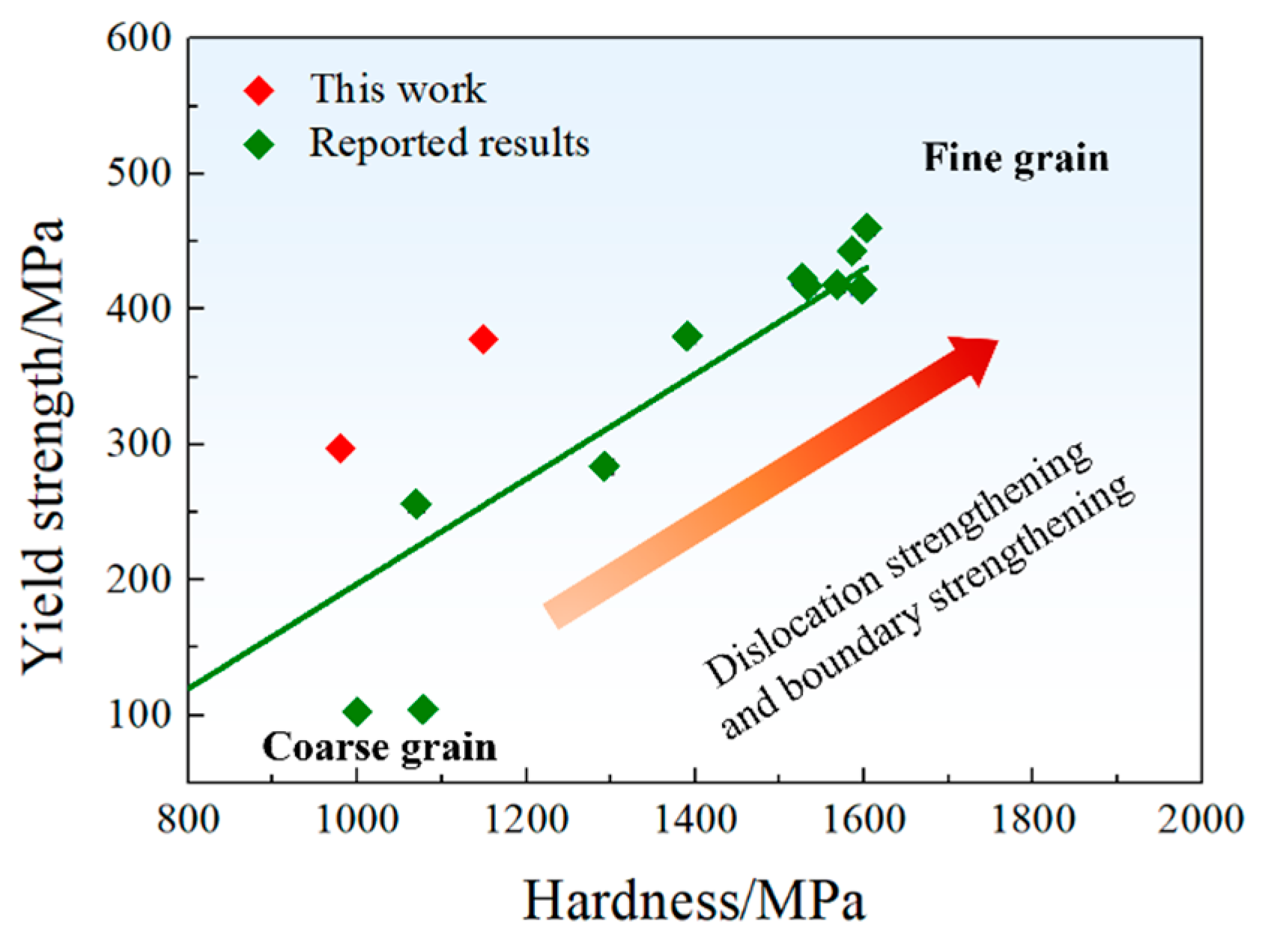
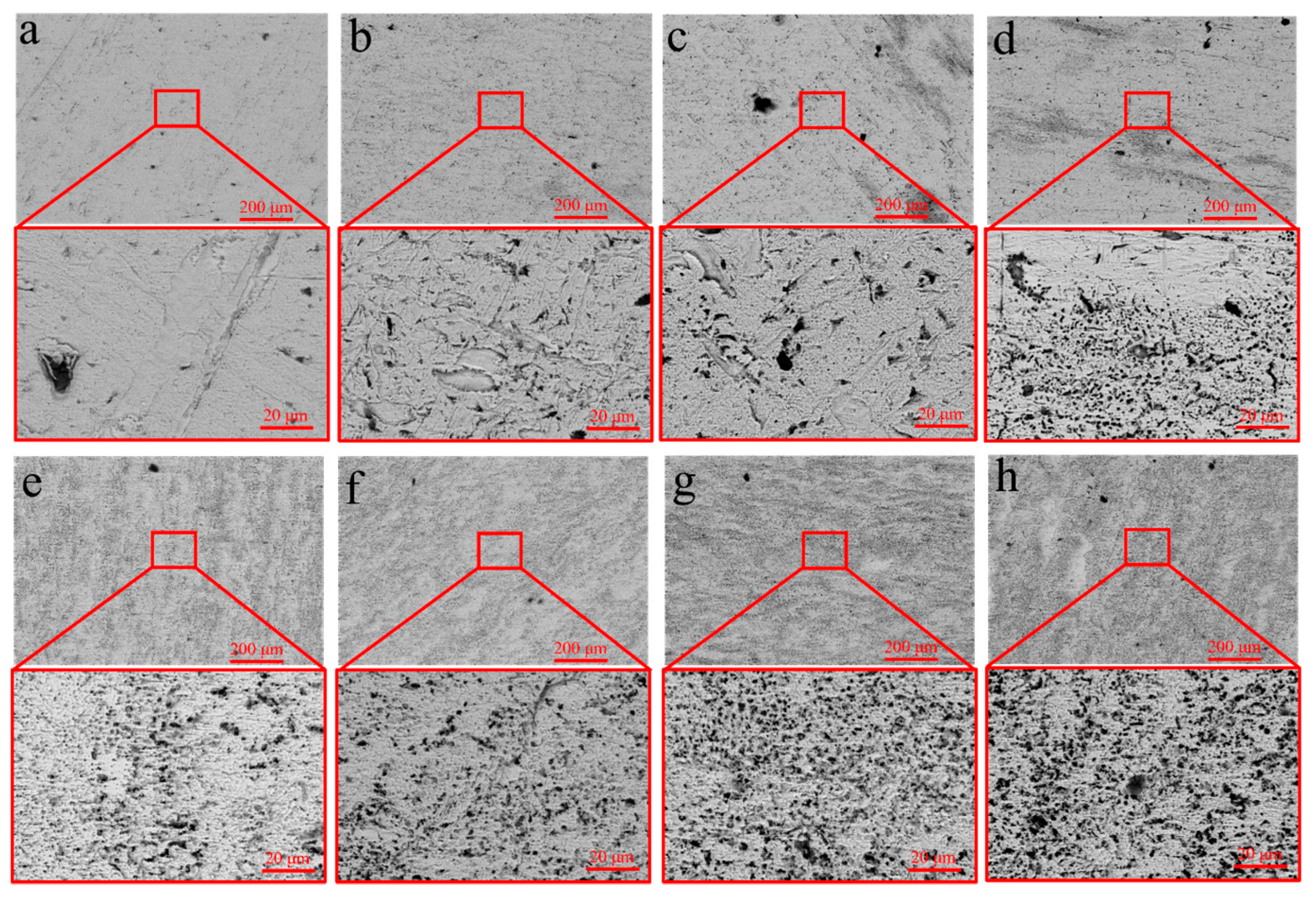


| Yield Strength | Ultimate Strength | Uniform Elongation | |
|---|---|---|---|
| Initial | 297 MPa | 504 MPa | 19.1% |
| USRPed | 378 MPa | 500 MPa | 14.6% |
| Specimen | Ecorr (VSCE) | icorr (μA/cm2) | βa (mV) | βc (mV) | Rp (Ω·cm2) | Chi-Square |
|---|---|---|---|---|---|---|
| Initial | −0.396 | 11.405 | 176.5 | 888.3 | 0.56 | 0.01 |
| USRPed | −0.272 | 3.238 | 117.3 | 289.1 | 1.13 | 0.017 |
| Specimen | Rs (Ω·cm2) | CPEdl | Rct (Ω·cm2) | Chi-Square | |
|---|---|---|---|---|---|
| Q (F cm−2 sn−1) | n | ||||
| Initial | 26.64 | 6.07 × 10−4 | 0.82 | 3132 | 0.021 |
| USRPed | 30.43 | 1.73 × 10−4 | 0.73 | 6806 | 0.011 |
Disclaimer/Publisher’s Note: The statements, opinions and data contained in all publications are solely those of the individual author(s) and contributor(s) and not of MDPI and/or the editor(s). MDPI and/or the editor(s) disclaim responsibility for any injury to people or property resulting from any ideas, methods, instructions or products referred to in the content. |
© 2023 by the authors. Licensee MDPI, Basel, Switzerland. This article is an open access article distributed under the terms and conditions of the Creative Commons Attribution (CC BY) license (https://creativecommons.org/licenses/by/4.0/).
Share and Cite
Guan, B.; Li, X.; Xu, J.; Fu, R.; Yan, C.; Huang, J.; Hu, Q.; Zou, J.; Liu, W.; Hu, Z. Mechanical and Corrosion Behavior of a Composite Gradient-Structured Cu-Fe Alloy. Metals 2023, 13, 1304. https://doi.org/10.3390/met13071304
Guan B, Li X, Xu J, Fu R, Yan C, Huang J, Hu Q, Zou J, Liu W, Hu Z. Mechanical and Corrosion Behavior of a Composite Gradient-Structured Cu-Fe Alloy. Metals. 2023; 13(7):1304. https://doi.org/10.3390/met13071304
Chicago/Turabian StyleGuan, Bo, Xiao Li, Jing Xu, Rui Fu, Changjian Yan, Jiawei Huang, Qiang Hu, Jin Zou, Wenzheng Liu, and Zhi Hu. 2023. "Mechanical and Corrosion Behavior of a Composite Gradient-Structured Cu-Fe Alloy" Metals 13, no. 7: 1304. https://doi.org/10.3390/met13071304
APA StyleGuan, B., Li, X., Xu, J., Fu, R., Yan, C., Huang, J., Hu, Q., Zou, J., Liu, W., & Hu, Z. (2023). Mechanical and Corrosion Behavior of a Composite Gradient-Structured Cu-Fe Alloy. Metals, 13(7), 1304. https://doi.org/10.3390/met13071304







